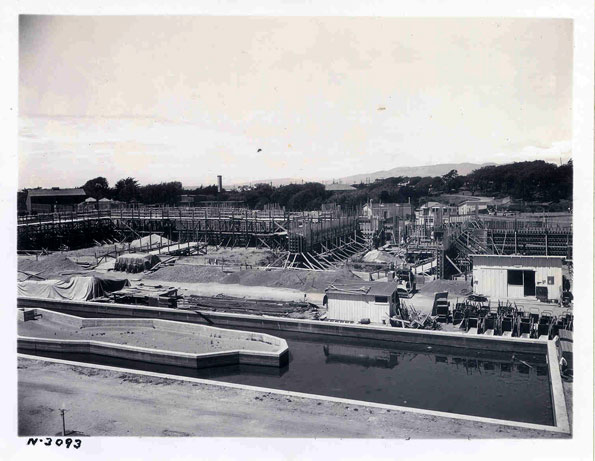From the humble beginnings of a lone California grizzly bear to state-of-the-art animal care and wellness, the rich history of the San Francisco Zoo explains the evolution of its mission to care, connect, and conserve.
Early 1800s: Woodward’s Gardens
In 1866, San Francisco’s wealthy Robert B. Woodward established Woodward’s Gardens, a four-acre amusement park in the Mission District with a diverse menagerie. The zoo at Woodward’s Gardens included notable exhibits like the sea lion pond, grizzly bear grottos, black swans, deer, and an aviary. As the city evolved, so did the idea of a dedicated zoo.
Late 1800s: The Bear Beginnings
The story of the San Francisco Zoo began over a century ago with a bear named Monarch, California’s last captive grizzly. Acquired in 1889 after a spirited debate initiated by media magnate William Randolph Hearst, Monarch became an iconic figure, surviving the 1906 earthquake and fire. Monarch’s legacy lives on, as he is forever commemorated on the California state flag.
1922: The Zoo Finds a Home
In 1922, Herbert Fleishhacker secured a 30-acre site near the ocean, marking the Zoo’s move from Golden Gate Park. Fleishhacker’s vision included diverse exhibits, a swimming pool, playfield, and carousel, creating a recreational haven. The first animals were transferred from Golden Gate Park, establishing the foundation for the Zoo’s future growth.
1929: The Birth of San Francisco Zoo
The San Francisco Zoo as we know it today was officially established in 1929, during the Great Depression, as part of a Works Progress Administration (WPA) project. Originally named The Herbert Fleishhacker Zoo after its founder, it was later renamed The San Francisco Zoological Gardens in 1941. The Zoo quickly became a symbol of hope and resilience during challenging times.
1930s: WPA Roots and Zoo Expansion
During the 1930s, the WPA played a crucial role in expanding the Zoo with new exhibits, including Monkey Island, Lion House, Elephant House, a sea lion pool, an aviary, and bear grottos. These innovative, moated enclosures were among the first bar-less exhibits in the country. Despite challenges, the Zoo flourished under the leadership of Director George Bistany.
1950s: The Zoological Society and Philanthropy
The San Francisco Zoological Society, founded in 1954, became a vital force for fundraising and development. Carroll Soo-Hoo’s philanthropic contributions, including 40 animals, significantly enriched the Zoo’s collection. The Society’s influence extended to exhibit development, renovations, and crucial projects, shaping the Zoo’s landscape.
Present Day: The New Zoo
In 1993, the San Francisco Zoological Society took over management, ushering in a new era of progress. A unique public/private Lease Partnership Agreement enabled significant improvements, including exhibit renovations and organizational enhancements. The Zoo’s commitment to conservation, education, and animal welfare remains strong, with ongoing efforts to create naturalistic habitats and enriching experiences for visitors.
The San Francisco Zoo has transformed from a modest menagerie in Woodward’s Gardens to a world-class institution dedicated to the well-being of animals and the conservation of wildlife. Its rich history serves as a testament to the city’s commitment to fostering a harmonious relationship between humans and the animal kingdom. Today, as visitors explore the Zoo’s diverse exhibits, they witness not only the evolution of the institution but also the enduring legacy of Monarch, the bear who symbolizes the city’s dedication to preserving vanishing wildlife.
Purchase your tickets to the San Francisco Zoo & Gardens today and experience the history up close!

